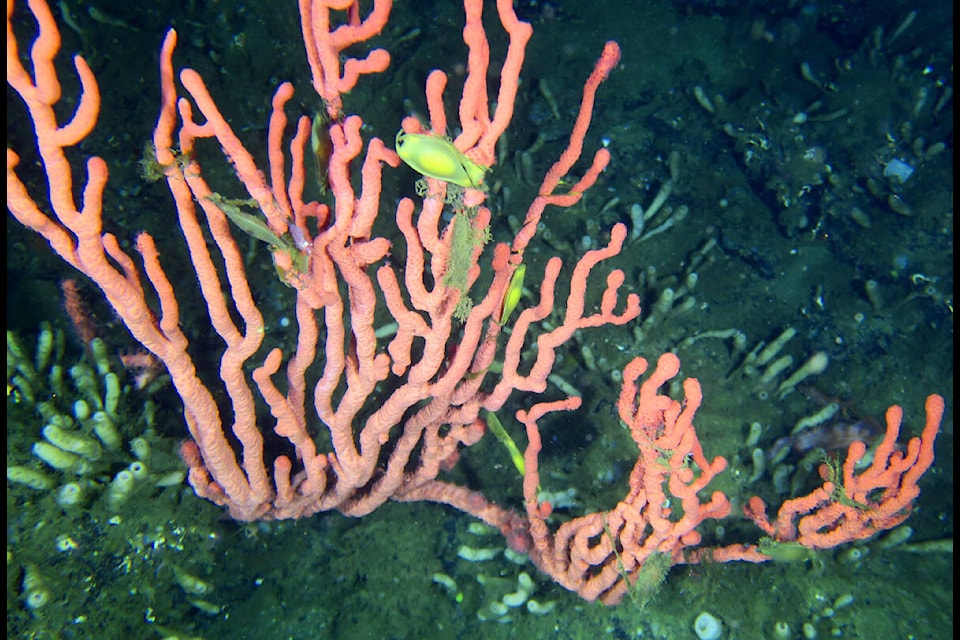A coral reef in Pacific Canada has been closed to commercial and recreational bottom-contact fishing, including mid-water trawl as of Feb. 14.
Located west of Bella Bella and just east of Klemtu in the Finlayson Channel, the Lophelia pertusa coral reef - known as qauciwisux by First Nations has cultural significance to the Kitasoo Xai’xais (Klemtu) and Heiltsuk (Bella Bella) First Nations.
Discovered in 2021 and mapped in 2022, the Lophelia coral reef is a “hidden gem,” said Dr. Cherisse Du Preez, head of the deep sea ecology program with Fisheries and Oceans Canada.
“This fisheries closure is really to prevent any physical harm because it is a one-time shot,” she told Black Press Media. “If you harm the reef it’s not a renewable resource. This is something that grows only a centimetre a year.”
Du Preez said the region was known for its abundance of fish to the First Nations.
“They did know there was something down there on the sea floor that was promoting all this life,” she said,
Douglas Neasloss, Chief Councillor for Kitasoo Xai’xais Nation, noted in a DFO news release the strong collaboration between First Nations and the federal government, where Indigenous knowledge harmoniously intertwines with scientific methods, has unveiled this “remarkable” ecosystem.
“Given the challenges posed by climate change and management uncertainties, we eagerly anticipate further cooperation with our Crown partners through the Marine Protected Area network action plan to preserve other ecologically and culturally significant regions,” he noted.
Protection of the unique habitat of the Lophelia reef and all the life it supports aligns well with the Heiltsuk Nation’s world view and laws, added Marilyn Slett, elected Chief Councillor Heiltsuk Tribal Council.
“Everything is connected and everything has a right to live in a healthy environment that supports healthy ecosystems and healthy populations that is free from unintended intrusion of destructive fishing practises,” Slett said.
In 2018, Du Preez, DFO, the Kitasoo Xai’xais Nation and the Central Coast Indigenous Resource Alliance began to survey the area together and returned every summer.
Through their expeditions, they began to find evidence of the coral and on the final dive in 2021 confirmed their suspicions.
They used a submersible robot, controlled in real time from the Coast Guard ship Vector, to go below the surface 500 to 600 metres, locating the Lophelia reef at 200 metres.
Although it was pitch dark, when they turned on the lights, they could see the reef’s beauty.
“It turns out it is a 25-acres of pristine coral reef. We discovered it together, with the Coastal First Nations, and we would go on this journey together,” Du Preez said. “The next step, obviously, was protection.”
Fortunately, there was not much historical fishing in the area of the reef, although there was evidence of long-lines and fishing traps and some breakage on the reef.
In Atlantic Canada, Du Preez noted, there was a similar Lophelia reef found about a decade ago because it was bottom-trawled and some coral came up in nets.
“That was the only other Lophelia reef that we know of that existed in that region, but it was significantly damaged,” she said of the East Coast one. “A conservation area has been established around that destroyed reef. Even if it grows a centimetre a year there is hope that one day it will come back.”
Du Preez said you don’t usually have deep sea coral reefs where there are herring, grizzly bears, seawolves and otters.
“As soon as you look at the science, and you look at the ecology, you are like, of course this is all connected. It’s hard to communicate that, especially with the deep sea when people think it is so far removed.”
By controlling stresses, such as fishing, will give the reef the best chance to survive and Du Preez hopes its discovery will lead to scouting out other reefs because of the benefits they provide to the environment.
“I hope we can actually discover, that no, this is not the only coral reef in Pacific Canada or the only one that is this far north.”
The day they confirmed the Lophelia reef there was a lot of yelling and some tears, Du Preez recalled.
“To discover something like this, it touches the human aspect of exploration.”
Don’t miss out on reading the latest local, provincial and national news offered at the Williams Lake Tribune. Sign up for our free newsletter here.
